CQU University PPMP20015 Term 1: Labour Cost Research Report
VerifiedAdded on 2022/09/22
|10
|2874
|22
Report
AI Summary
This report presents a research proposal examining the challenges in controlling labor costs within the construction/engineering projects in Perth, Australia. The research identifies a gap in the existing literature, focusing on the impact of wage growth slowdown and the challenges faced by construction companies. The report includes a detailed literature review of ten scholarly journal articles, exploring issues such as high labor costs, skilled labor shortages, and negative perceptions of construction careers. It also outlines the research questions and objectives, aiming to understand the causes behind increasing labor costs and their effects on the industry's growth and profitability. The proposed methodology combines qualitative and quantitative methods, including interviews, surveys, and observations to gather relevant data and information. The report also discusses the credibility of the articles used, the research questions, and the purpose of the research methodology.
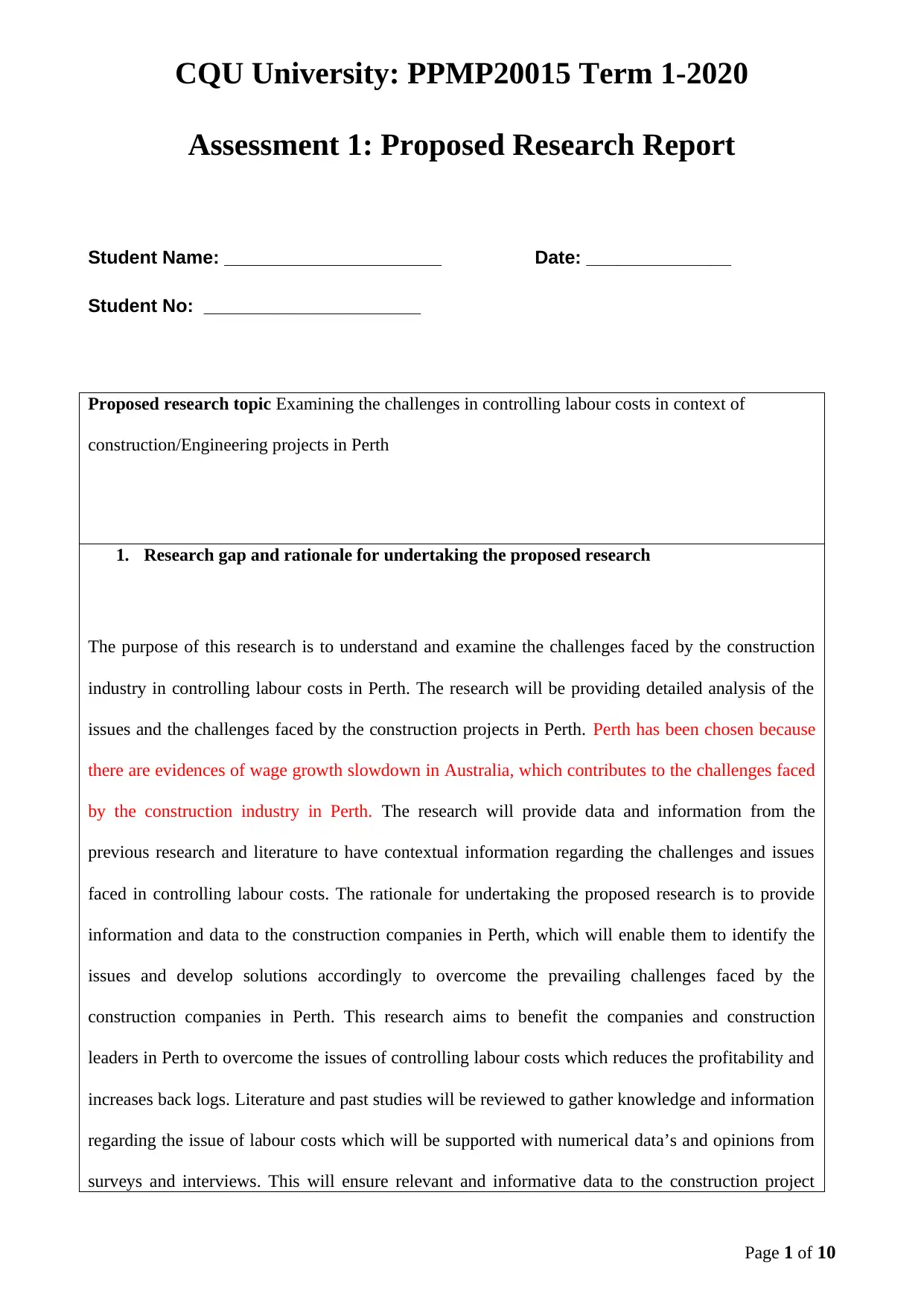
CQU University: PPMP20015 Term 1-2020
Assessment 1: Proposed Research Report
Student Name: _____________________ Date: ______________
Student No: _____________________
Proposed research topic Examining the challenges in controlling labour costs in context of
construction/Engineering projects in Perth
1. Research gap and rationale for undertaking the proposed research
The purpose of this research is to understand and examine the challenges faced by the construction
industry in controlling labour costs in Perth. The research will be providing detailed analysis of the
issues and the challenges faced by the construction projects in Perth. Perth has been chosen because
there are evidences of wage growth slowdown in Australia, which contributes to the challenges faced
by the construction industry in Perth. The research will provide data and information from the
previous research and literature to have contextual information regarding the challenges and issues
faced in controlling labour costs. The rationale for undertaking the proposed research is to provide
information and data to the construction companies in Perth, which will enable them to identify the
issues and develop solutions accordingly to overcome the prevailing challenges faced by the
construction companies in Perth. This research aims to benefit the companies and construction
leaders in Perth to overcome the issues of controlling labour costs which reduces the profitability and
increases back logs. Literature and past studies will be reviewed to gather knowledge and information
regarding the issue of labour costs which will be supported with numerical data’s and opinions from
surveys and interviews. This will ensure relevant and informative data to the construction project
Page 1 of 10
Assessment 1: Proposed Research Report
Student Name: _____________________ Date: ______________
Student No: _____________________
Proposed research topic Examining the challenges in controlling labour costs in context of
construction/Engineering projects in Perth
1. Research gap and rationale for undertaking the proposed research
The purpose of this research is to understand and examine the challenges faced by the construction
industry in controlling labour costs in Perth. The research will be providing detailed analysis of the
issues and the challenges faced by the construction projects in Perth. Perth has been chosen because
there are evidences of wage growth slowdown in Australia, which contributes to the challenges faced
by the construction industry in Perth. The research will provide data and information from the
previous research and literature to have contextual information regarding the challenges and issues
faced in controlling labour costs. The rationale for undertaking the proposed research is to provide
information and data to the construction companies in Perth, which will enable them to identify the
issues and develop solutions accordingly to overcome the prevailing challenges faced by the
construction companies in Perth. This research aims to benefit the companies and construction
leaders in Perth to overcome the issues of controlling labour costs which reduces the profitability and
increases back logs. Literature and past studies will be reviewed to gather knowledge and information
regarding the issue of labour costs which will be supported with numerical data’s and opinions from
surveys and interviews. This will ensure relevant and informative data to the construction project
Page 1 of 10
Paraphrase This Document
Need a fresh take? Get an instant paraphrase of this document with our AI Paraphraser
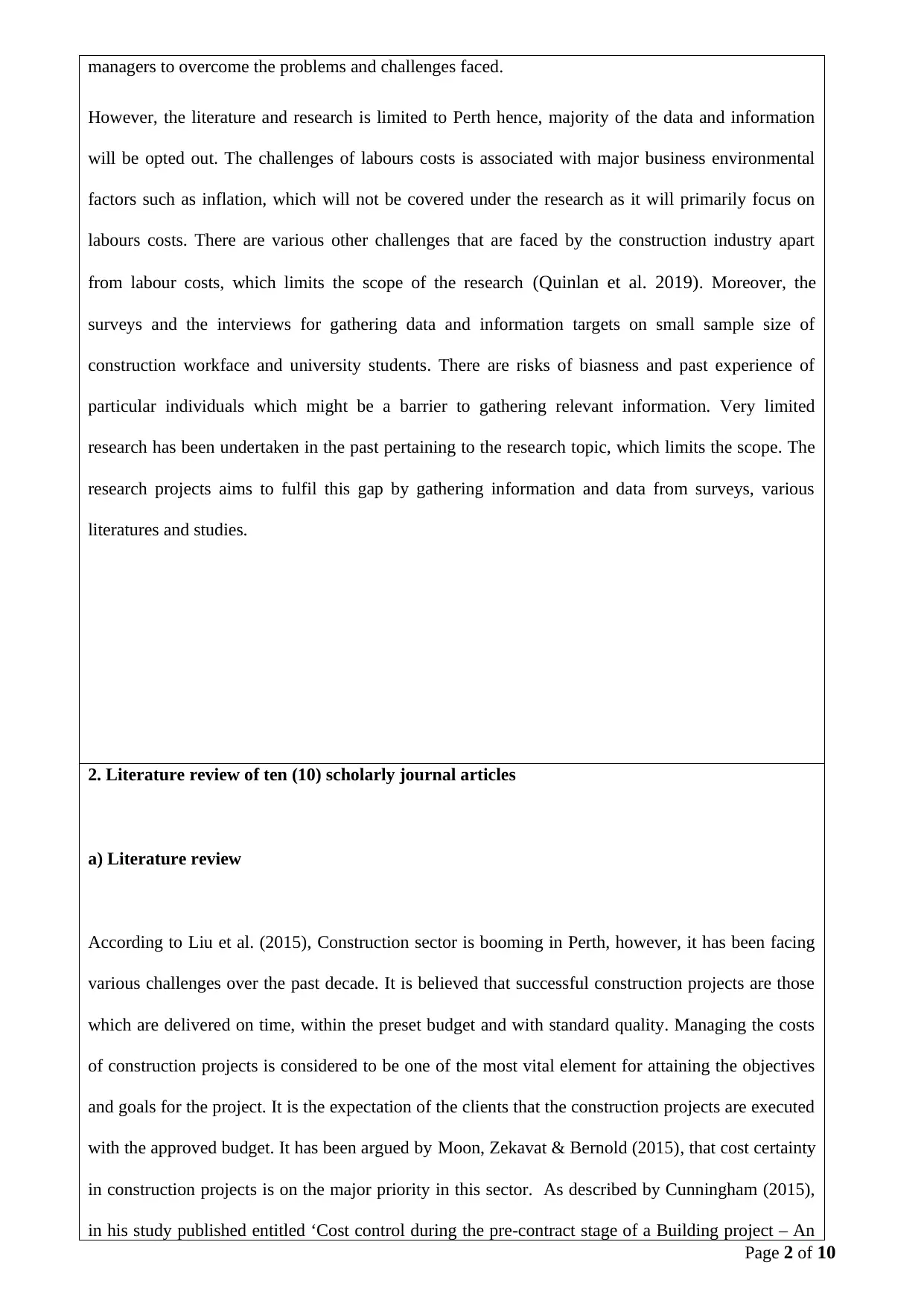
managers to overcome the problems and challenges faced.
However, the literature and research is limited to Perth hence, majority of the data and information
will be opted out. The challenges of labours costs is associated with major business environmental
factors such as inflation, which will not be covered under the research as it will primarily focus on
labours costs. There are various other challenges that are faced by the construction industry apart
from labour costs, which limits the scope of the research (Quinlan et al. 2019). Moreover, the
surveys and the interviews for gathering data and information targets on small sample size of
construction workface and university students. There are risks of biasness and past experience of
particular individuals which might be a barrier to gathering relevant information. Very limited
research has been undertaken in the past pertaining to the research topic, which limits the scope. The
research projects aims to fulfil this gap by gathering information and data from surveys, various
literatures and studies.
2. Literature review of ten (10) scholarly journal articles
a) Literature review
According to Liu et al. (2015), Construction sector is booming in Perth, however, it has been facing
various challenges over the past decade. It is believed that successful construction projects are those
which are delivered on time, within the preset budget and with standard quality. Managing the costs
of construction projects is considered to be one of the most vital element for attaining the objectives
and goals for the project. It is the expectation of the clients that the construction projects are executed
with the approved budget. It has been argued by Moon, Zekavat & Bernold (2015), that cost certainty
in construction projects is on the major priority in this sector. As described by Cunningham (2015),
in his study published entitled ‘Cost control during the pre-contract stage of a Building project – An
Page 2 of 10
However, the literature and research is limited to Perth hence, majority of the data and information
will be opted out. The challenges of labours costs is associated with major business environmental
factors such as inflation, which will not be covered under the research as it will primarily focus on
labours costs. There are various other challenges that are faced by the construction industry apart
from labour costs, which limits the scope of the research (Quinlan et al. 2019). Moreover, the
surveys and the interviews for gathering data and information targets on small sample size of
construction workface and university students. There are risks of biasness and past experience of
particular individuals which might be a barrier to gathering relevant information. Very limited
research has been undertaken in the past pertaining to the research topic, which limits the scope. The
research projects aims to fulfil this gap by gathering information and data from surveys, various
literatures and studies.
2. Literature review of ten (10) scholarly journal articles
a) Literature review
According to Liu et al. (2015), Construction sector is booming in Perth, however, it has been facing
various challenges over the past decade. It is believed that successful construction projects are those
which are delivered on time, within the preset budget and with standard quality. Managing the costs
of construction projects is considered to be one of the most vital element for attaining the objectives
and goals for the project. It is the expectation of the clients that the construction projects are executed
with the approved budget. It has been argued by Moon, Zekavat & Bernold (2015), that cost certainty
in construction projects is on the major priority in this sector. As described by Cunningham (2015),
in his study published entitled ‘Cost control during the pre-contract stage of a Building project – An
Page 2 of 10
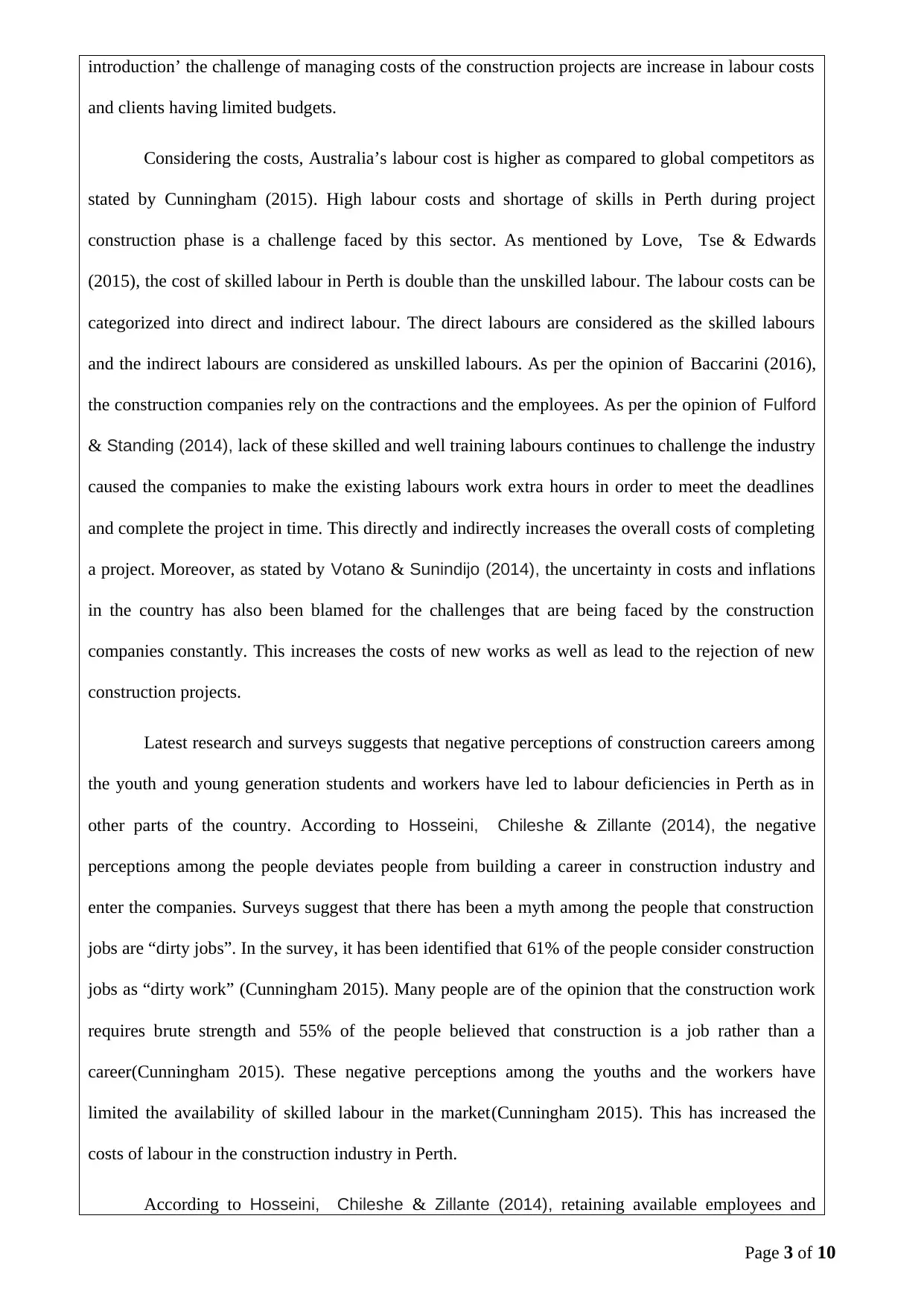
introduction’ the challenge of managing costs of the construction projects are increase in labour costs
and clients having limited budgets.
Considering the costs, Australia’s labour cost is higher as compared to global competitors as
stated by Cunningham (2015). High labour costs and shortage of skills in Perth during project
construction phase is a challenge faced by this sector. As mentioned by Love, Tse & Edwards
(2015), the cost of skilled labour in Perth is double than the unskilled labour. The labour costs can be
categorized into direct and indirect labour. The direct labours are considered as the skilled labours
and the indirect labours are considered as unskilled labours. As per the opinion of Baccarini (2016),
the construction companies rely on the contractions and the employees. As per the opinion of Fulford
& Standing (2014), lack of these skilled and well training labours continues to challenge the industry
caused the companies to make the existing labours work extra hours in order to meet the deadlines
and complete the project in time. This directly and indirectly increases the overall costs of completing
a project. Moreover, as stated by Votano & Sunindijo (2014), the uncertainty in costs and inflations
in the country has also been blamed for the challenges that are being faced by the construction
companies constantly. This increases the costs of new works as well as lead to the rejection of new
construction projects.
Latest research and surveys suggests that negative perceptions of construction careers among
the youth and young generation students and workers have led to labour deficiencies in Perth as in
other parts of the country. According to Hosseini, Chileshe & Zillante (2014), the negative
perceptions among the people deviates people from building a career in construction industry and
enter the companies. Surveys suggest that there has been a myth among the people that construction
jobs are “dirty jobs”. In the survey, it has been identified that 61% of the people consider construction
jobs as “dirty work” (Cunningham 2015). Many people are of the opinion that the construction work
requires brute strength and 55% of the people believed that construction is a job rather than a
career(Cunningham 2015). These negative perceptions among the youths and the workers have
limited the availability of skilled labour in the market(Cunningham 2015). This has increased the
costs of labour in the construction industry in Perth.
According to Hosseini, Chileshe & Zillante (2014), retaining available employees and
Page 3 of 10
and clients having limited budgets.
Considering the costs, Australia’s labour cost is higher as compared to global competitors as
stated by Cunningham (2015). High labour costs and shortage of skills in Perth during project
construction phase is a challenge faced by this sector. As mentioned by Love, Tse & Edwards
(2015), the cost of skilled labour in Perth is double than the unskilled labour. The labour costs can be
categorized into direct and indirect labour. The direct labours are considered as the skilled labours
and the indirect labours are considered as unskilled labours. As per the opinion of Baccarini (2016),
the construction companies rely on the contractions and the employees. As per the opinion of Fulford
& Standing (2014), lack of these skilled and well training labours continues to challenge the industry
caused the companies to make the existing labours work extra hours in order to meet the deadlines
and complete the project in time. This directly and indirectly increases the overall costs of completing
a project. Moreover, as stated by Votano & Sunindijo (2014), the uncertainty in costs and inflations
in the country has also been blamed for the challenges that are being faced by the construction
companies constantly. This increases the costs of new works as well as lead to the rejection of new
construction projects.
Latest research and surveys suggests that negative perceptions of construction careers among
the youth and young generation students and workers have led to labour deficiencies in Perth as in
other parts of the country. According to Hosseini, Chileshe & Zillante (2014), the negative
perceptions among the people deviates people from building a career in construction industry and
enter the companies. Surveys suggest that there has been a myth among the people that construction
jobs are “dirty jobs”. In the survey, it has been identified that 61% of the people consider construction
jobs as “dirty work” (Cunningham 2015). Many people are of the opinion that the construction work
requires brute strength and 55% of the people believed that construction is a job rather than a
career(Cunningham 2015). These negative perceptions among the youths and the workers have
limited the availability of skilled labour in the market(Cunningham 2015). This has increased the
costs of labour in the construction industry in Perth.
According to Hosseini, Chileshe & Zillante (2014), retaining available employees and
Page 3 of 10
⊘ This is a preview!⊘
Do you want full access?
Subscribe today to unlock all pages.

Trusted by 1+ million students worldwide
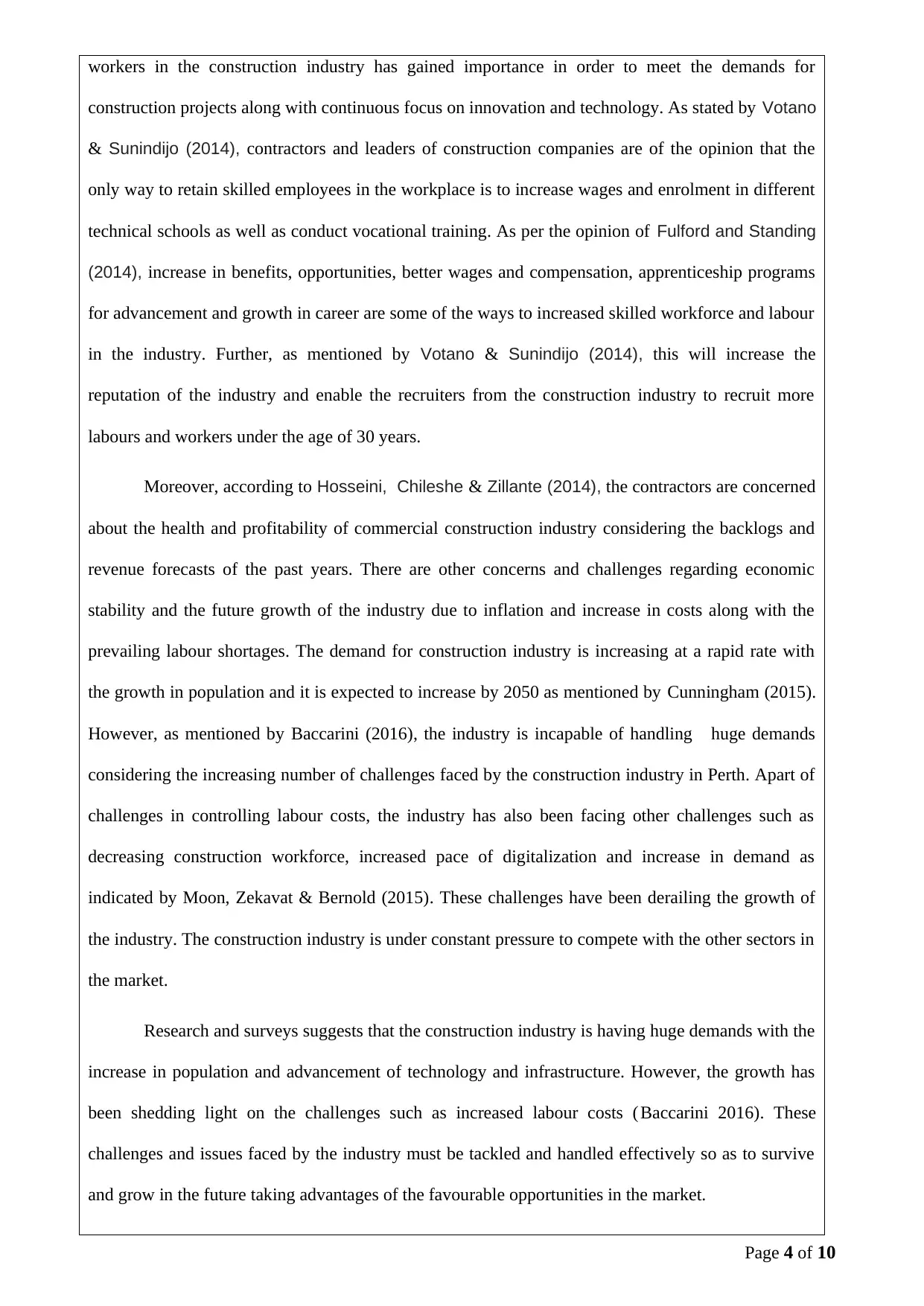
workers in the construction industry has gained importance in order to meet the demands for
construction projects along with continuous focus on innovation and technology. As stated by Votano
& Sunindijo (2014), contractors and leaders of construction companies are of the opinion that the
only way to retain skilled employees in the workplace is to increase wages and enrolment in different
technical schools as well as conduct vocational training. As per the opinion of Fulford and Standing
(2014), increase in benefits, opportunities, better wages and compensation, apprenticeship programs
for advancement and growth in career are some of the ways to increased skilled workforce and labour
in the industry. Further, as mentioned by Votano & Sunindijo (2014), this will increase the
reputation of the industry and enable the recruiters from the construction industry to recruit more
labours and workers under the age of 30 years.
Moreover, according to Hosseini, Chileshe & Zillante (2014), the contractors are concerned
about the health and profitability of commercial construction industry considering the backlogs and
revenue forecasts of the past years. There are other concerns and challenges regarding economic
stability and the future growth of the industry due to inflation and increase in costs along with the
prevailing labour shortages. The demand for construction industry is increasing at a rapid rate with
the growth in population and it is expected to increase by 2050 as mentioned by Cunningham (2015).
However, as mentioned by Baccarini (2016), the industry is incapable of handling huge demands
considering the increasing number of challenges faced by the construction industry in Perth. Apart of
challenges in controlling labour costs, the industry has also been facing other challenges such as
decreasing construction workforce, increased pace of digitalization and increase in demand as
indicated by Moon, Zekavat & Bernold (2015). These challenges have been derailing the growth of
the industry. The construction industry is under constant pressure to compete with the other sectors in
the market.
Research and surveys suggests that the construction industry is having huge demands with the
increase in population and advancement of technology and infrastructure. However, the growth has
been shedding light on the challenges such as increased labour costs ( Baccarini 2016). These
challenges and issues faced by the industry must be tackled and handled effectively so as to survive
and grow in the future taking advantages of the favourable opportunities in the market.
Page 4 of 10
construction projects along with continuous focus on innovation and technology. As stated by Votano
& Sunindijo (2014), contractors and leaders of construction companies are of the opinion that the
only way to retain skilled employees in the workplace is to increase wages and enrolment in different
technical schools as well as conduct vocational training. As per the opinion of Fulford and Standing
(2014), increase in benefits, opportunities, better wages and compensation, apprenticeship programs
for advancement and growth in career are some of the ways to increased skilled workforce and labour
in the industry. Further, as mentioned by Votano & Sunindijo (2014), this will increase the
reputation of the industry and enable the recruiters from the construction industry to recruit more
labours and workers under the age of 30 years.
Moreover, according to Hosseini, Chileshe & Zillante (2014), the contractors are concerned
about the health and profitability of commercial construction industry considering the backlogs and
revenue forecasts of the past years. There are other concerns and challenges regarding economic
stability and the future growth of the industry due to inflation and increase in costs along with the
prevailing labour shortages. The demand for construction industry is increasing at a rapid rate with
the growth in population and it is expected to increase by 2050 as mentioned by Cunningham (2015).
However, as mentioned by Baccarini (2016), the industry is incapable of handling huge demands
considering the increasing number of challenges faced by the construction industry in Perth. Apart of
challenges in controlling labour costs, the industry has also been facing other challenges such as
decreasing construction workforce, increased pace of digitalization and increase in demand as
indicated by Moon, Zekavat & Bernold (2015). These challenges have been derailing the growth of
the industry. The construction industry is under constant pressure to compete with the other sectors in
the market.
Research and surveys suggests that the construction industry is having huge demands with the
increase in population and advancement of technology and infrastructure. However, the growth has
been shedding light on the challenges such as increased labour costs ( Baccarini 2016). These
challenges and issues faced by the industry must be tackled and handled effectively so as to survive
and grow in the future taking advantages of the favourable opportunities in the market.
Page 4 of 10
Paraphrase This Document
Need a fresh take? Get an instant paraphrase of this document with our AI Paraphraser
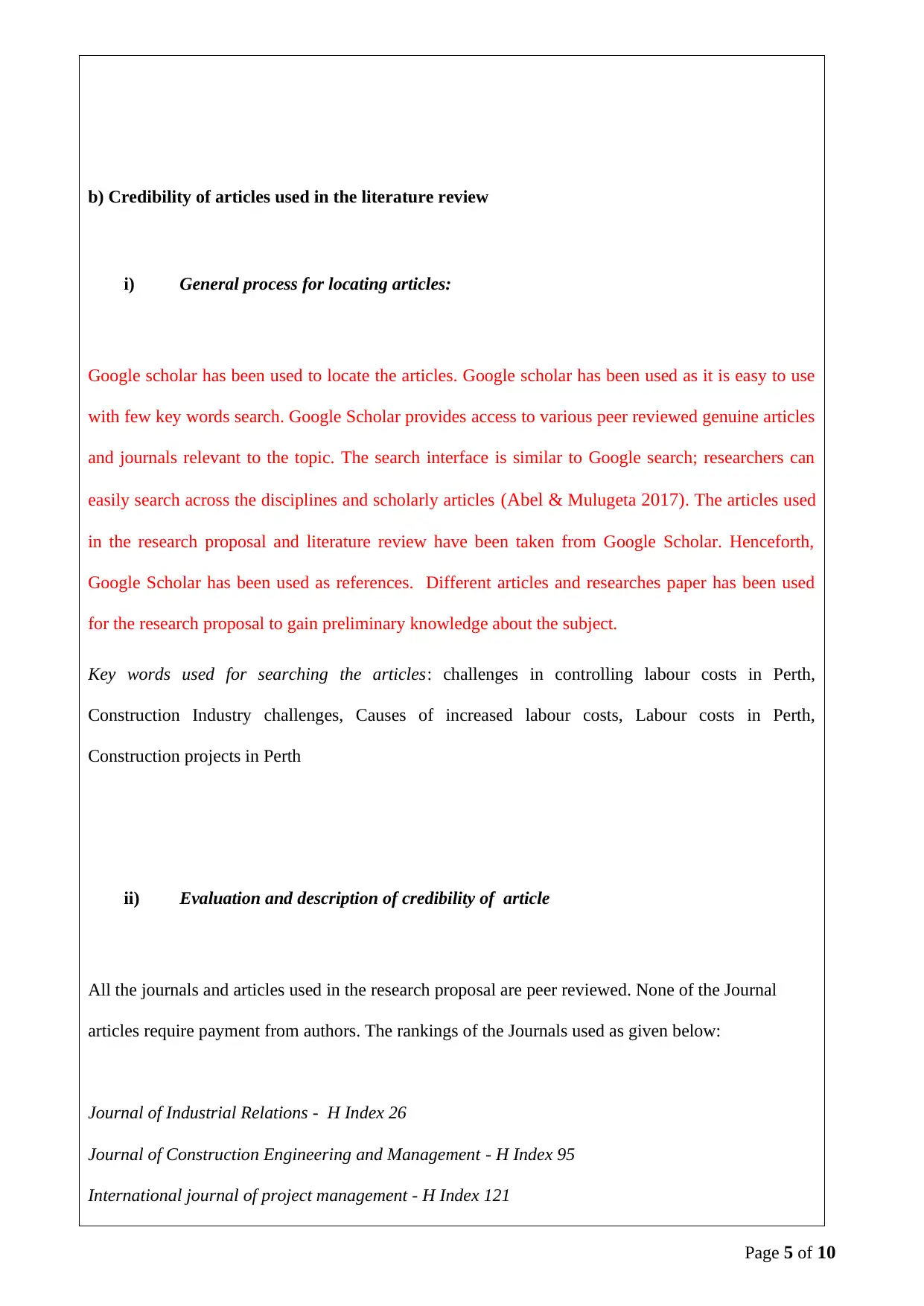
b) Credibility of articles used in the literature review
i) General process for locating articles:
Google scholar has been used to locate the articles. Google scholar has been used as it is easy to use
with few key words search. Google Scholar provides access to various peer reviewed genuine articles
and journals relevant to the topic. The search interface is similar to Google search; researchers can
easily search across the disciplines and scholarly articles (Abel & Mulugeta 2017). The articles used
in the research proposal and literature review have been taken from Google Scholar. Henceforth,
Google Scholar has been used as references. Different articles and researches paper has been used
for the research proposal to gain preliminary knowledge about the subject.
Key words used for searching the articles: challenges in controlling labour costs in Perth,
Construction Industry challenges, Causes of increased labour costs, Labour costs in Perth,
Construction projects in Perth
ii) Evaluation and description of credibility of article
All the journals and articles used in the research proposal are peer reviewed. None of the Journal
articles require payment from authors. The rankings of the Journals used as given below:
Journal of Industrial Relations - H Index 26
Journal of Construction Engineering and Management - H Index 95
International journal of project management - H Index 121
Page 5 of 10
i) General process for locating articles:
Google scholar has been used to locate the articles. Google scholar has been used as it is easy to use
with few key words search. Google Scholar provides access to various peer reviewed genuine articles
and journals relevant to the topic. The search interface is similar to Google search; researchers can
easily search across the disciplines and scholarly articles (Abel & Mulugeta 2017). The articles used
in the research proposal and literature review have been taken from Google Scholar. Henceforth,
Google Scholar has been used as references. Different articles and researches paper has been used
for the research proposal to gain preliminary knowledge about the subject.
Key words used for searching the articles: challenges in controlling labour costs in Perth,
Construction Industry challenges, Causes of increased labour costs, Labour costs in Perth,
Construction projects in Perth
ii) Evaluation and description of credibility of article
All the journals and articles used in the research proposal are peer reviewed. None of the Journal
articles require payment from authors. The rankings of the Journals used as given below:
Journal of Industrial Relations - H Index 26
Journal of Construction Engineering and Management - H Index 95
International journal of project management - H Index 121
Page 5 of 10
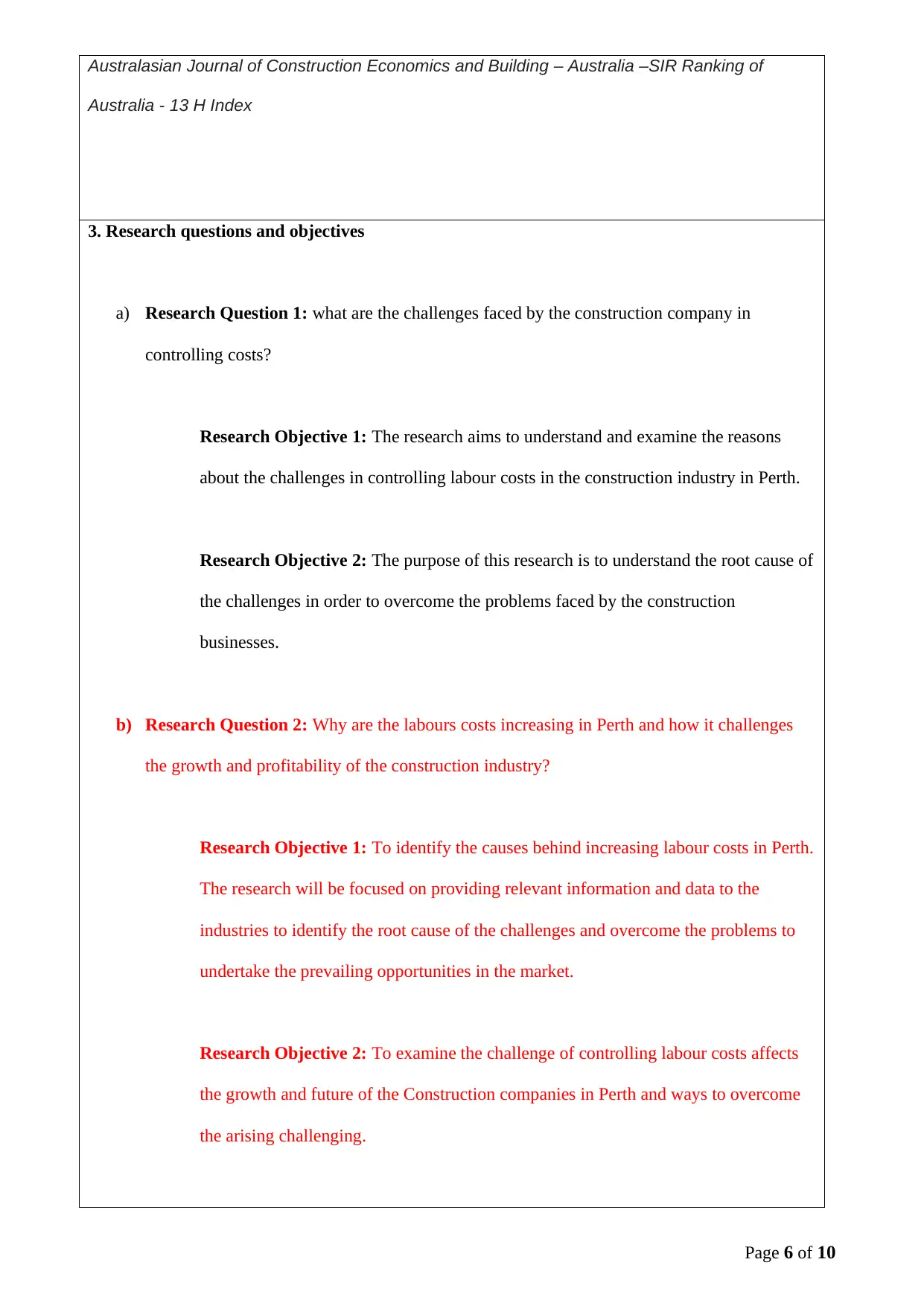
Australasian Journal of Construction Economics and Building – Australia –SIR Ranking of
Australia - 13 H Index
3. Research questions and objectives
a) Research Question 1: what are the challenges faced by the construction company in
controlling costs?
Research Objective 1: The research aims to understand and examine the reasons
about the challenges in controlling labour costs in the construction industry in Perth.
Research Objective 2: The purpose of this research is to understand the root cause of
the challenges in order to overcome the problems faced by the construction
businesses.
b) Research Question 2: Why are the labours costs increasing in Perth and how it challenges
the growth and profitability of the construction industry?
Research Objective 1: To identify the causes behind increasing labour costs in Perth.
The research will be focused on providing relevant information and data to the
industries to identify the root cause of the challenges and overcome the problems to
undertake the prevailing opportunities in the market.
Research Objective 2: To examine the challenge of controlling labour costs affects
the growth and future of the Construction companies in Perth and ways to overcome
the arising challenging.
Page 6 of 10
Australia - 13 H Index
3. Research questions and objectives
a) Research Question 1: what are the challenges faced by the construction company in
controlling costs?
Research Objective 1: The research aims to understand and examine the reasons
about the challenges in controlling labour costs in the construction industry in Perth.
Research Objective 2: The purpose of this research is to understand the root cause of
the challenges in order to overcome the problems faced by the construction
businesses.
b) Research Question 2: Why are the labours costs increasing in Perth and how it challenges
the growth and profitability of the construction industry?
Research Objective 1: To identify the causes behind increasing labour costs in Perth.
The research will be focused on providing relevant information and data to the
industries to identify the root cause of the challenges and overcome the problems to
undertake the prevailing opportunities in the market.
Research Objective 2: To examine the challenge of controlling labour costs affects
the growth and future of the Construction companies in Perth and ways to overcome
the arising challenging.
Page 6 of 10
⊘ This is a preview!⊘
Do you want full access?
Subscribe today to unlock all pages.

Trusted by 1+ million students worldwide
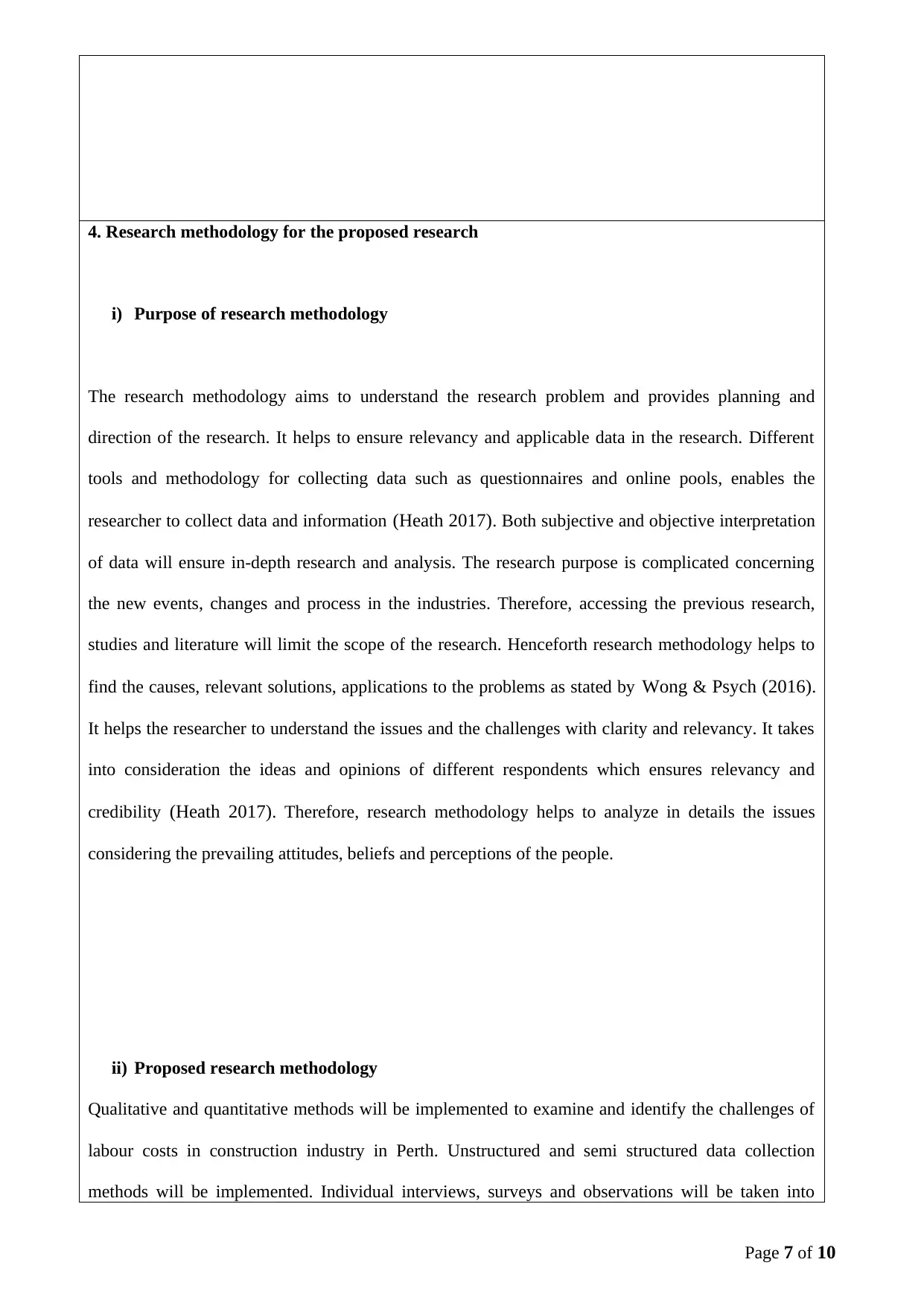
4. Research methodology for the proposed research
i) Purpose of research methodology
The research methodology aims to understand the research problem and provides planning and
direction of the research. It helps to ensure relevancy and applicable data in the research. Different
tools and methodology for collecting data such as questionnaires and online pools, enables the
researcher to collect data and information (Heath 2017). Both subjective and objective interpretation
of data will ensure in-depth research and analysis. The research purpose is complicated concerning
the new events, changes and process in the industries. Therefore, accessing the previous research,
studies and literature will limit the scope of the research. Henceforth research methodology helps to
find the causes, relevant solutions, applications to the problems as stated by Wong & Psych (2016).
It helps the researcher to understand the issues and the challenges with clarity and relevancy. It takes
into consideration the ideas and opinions of different respondents which ensures relevancy and
credibility (Heath 2017). Therefore, research methodology helps to analyze in details the issues
considering the prevailing attitudes, beliefs and perceptions of the people.
ii) Proposed research methodology
Qualitative and quantitative methods will be implemented to examine and identify the challenges of
labour costs in construction industry in Perth. Unstructured and semi structured data collection
methods will be implemented. Individual interviews, surveys and observations will be taken into
Page 7 of 10
i) Purpose of research methodology
The research methodology aims to understand the research problem and provides planning and
direction of the research. It helps to ensure relevancy and applicable data in the research. Different
tools and methodology for collecting data such as questionnaires and online pools, enables the
researcher to collect data and information (Heath 2017). Both subjective and objective interpretation
of data will ensure in-depth research and analysis. The research purpose is complicated concerning
the new events, changes and process in the industries. Therefore, accessing the previous research,
studies and literature will limit the scope of the research. Henceforth research methodology helps to
find the causes, relevant solutions, applications to the problems as stated by Wong & Psych (2016).
It helps the researcher to understand the issues and the challenges with clarity and relevancy. It takes
into consideration the ideas and opinions of different respondents which ensures relevancy and
credibility (Heath 2017). Therefore, research methodology helps to analyze in details the issues
considering the prevailing attitudes, beliefs and perceptions of the people.
ii) Proposed research methodology
Qualitative and quantitative methods will be implemented to examine and identify the challenges of
labour costs in construction industry in Perth. Unstructured and semi structured data collection
methods will be implemented. Individual interviews, surveys and observations will be taken into
Page 7 of 10
Paraphrase This Document
Need a fresh take? Get an instant paraphrase of this document with our AI Paraphraser
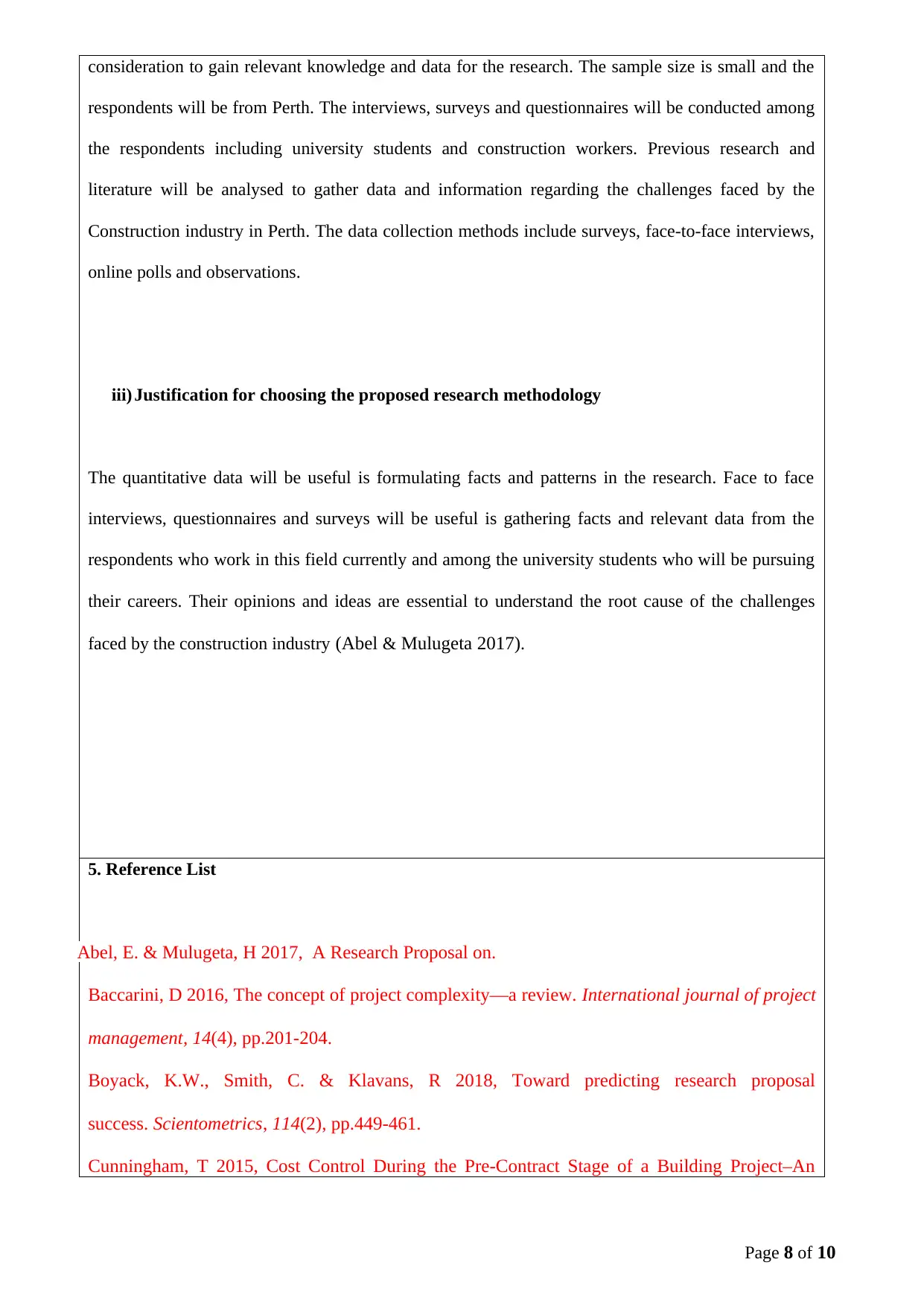
consideration to gain relevant knowledge and data for the research. The sample size is small and the
respondents will be from Perth. The interviews, surveys and questionnaires will be conducted among
the respondents including university students and construction workers. Previous research and
literature will be analysed to gather data and information regarding the challenges faced by the
Construction industry in Perth. The data collection methods include surveys, face-to-face interviews,
online polls and observations.
iii) Justification for choosing the proposed research methodology
The quantitative data will be useful is formulating facts and patterns in the research. Face to face
interviews, questionnaires and surveys will be useful is gathering facts and relevant data from the
respondents who work in this field currently and among the university students who will be pursuing
their careers. Their opinions and ideas are essential to understand the root cause of the challenges
faced by the construction industry (Abel & Mulugeta 2017).
5. Reference List
Abel, E. & Mulugeta, H 2017, A Research Proposal on.
Baccarini, D 2016, The concept of project complexity—a review. International journal of project
management, 14(4), pp.201-204.
Boyack, K.W., Smith, C. & Klavans, R 2018, Toward predicting research proposal
success. Scientometrics, 114(2), pp.449-461.
Cunningham, T 2015, Cost Control During the Pre-Contract Stage of a Building Project–An
Page 8 of 10
respondents will be from Perth. The interviews, surveys and questionnaires will be conducted among
the respondents including university students and construction workers. Previous research and
literature will be analysed to gather data and information regarding the challenges faced by the
Construction industry in Perth. The data collection methods include surveys, face-to-face interviews,
online polls and observations.
iii) Justification for choosing the proposed research methodology
The quantitative data will be useful is formulating facts and patterns in the research. Face to face
interviews, questionnaires and surveys will be useful is gathering facts and relevant data from the
respondents who work in this field currently and among the university students who will be pursuing
their careers. Their opinions and ideas are essential to understand the root cause of the challenges
faced by the construction industry (Abel & Mulugeta 2017).
5. Reference List
Abel, E. & Mulugeta, H 2017, A Research Proposal on.
Baccarini, D 2016, The concept of project complexity—a review. International journal of project
management, 14(4), pp.201-204.
Boyack, K.W., Smith, C. & Klavans, R 2018, Toward predicting research proposal
success. Scientometrics, 114(2), pp.449-461.
Cunningham, T 2015, Cost Control During the Pre-Contract Stage of a Building Project–An
Page 8 of 10
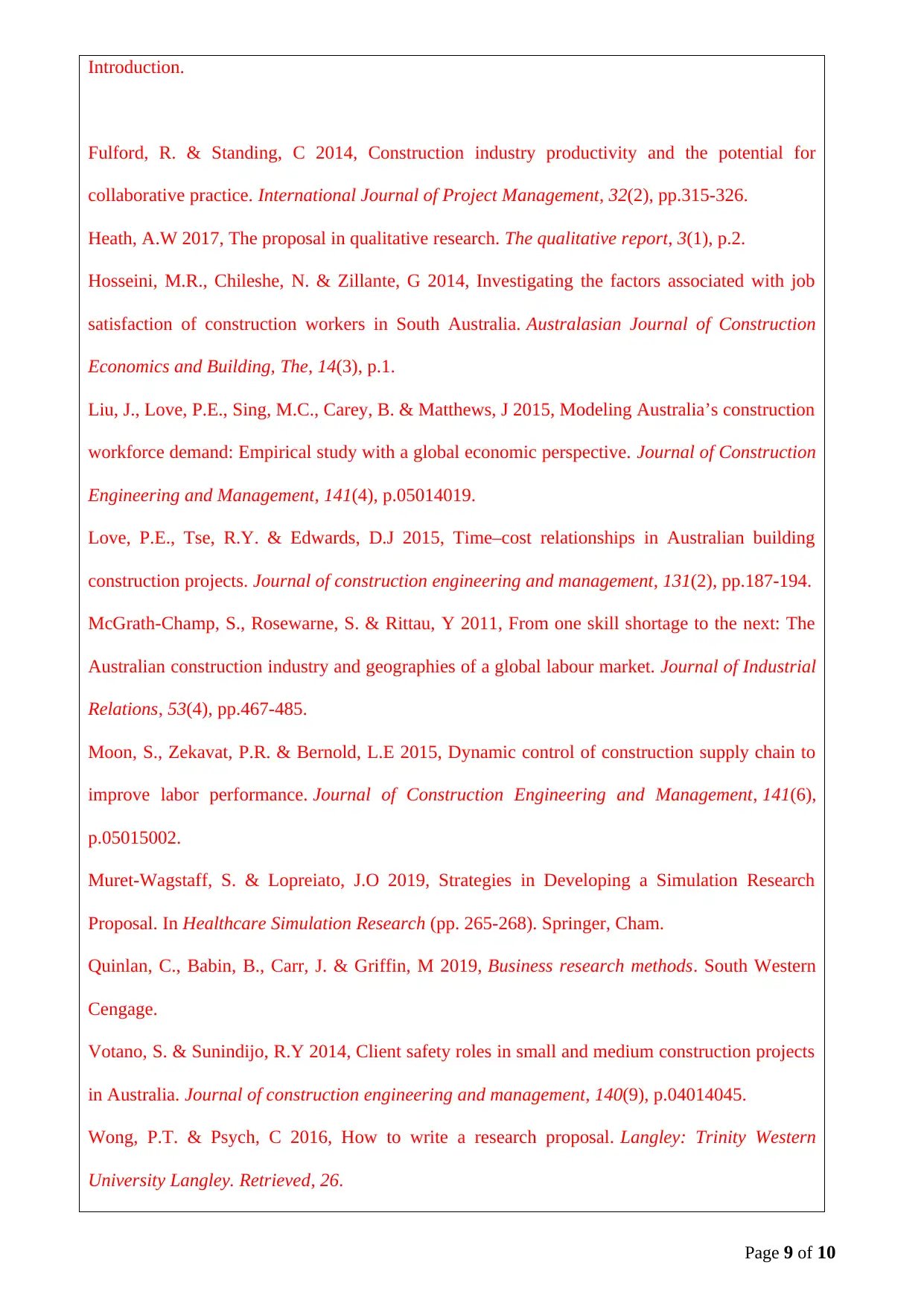
Introduction.
Fulford, R. & Standing, C 2014, Construction industry productivity and the potential for
collaborative practice. International Journal of Project Management, 32(2), pp.315-326.
Heath, A.W 2017, The proposal in qualitative research. The qualitative report, 3(1), p.2.
Hosseini, M.R., Chileshe, N. & Zillante, G 2014, Investigating the factors associated with job
satisfaction of construction workers in South Australia. Australasian Journal of Construction
Economics and Building, The, 14(3), p.1.
Liu, J., Love, P.E., Sing, M.C., Carey, B. & Matthews, J 2015, Modeling Australia’s construction
workforce demand: Empirical study with a global economic perspective. Journal of Construction
Engineering and Management, 141(4), p.05014019.
Love, P.E., Tse, R.Y. & Edwards, D.J 2015, Time–cost relationships in Australian building
construction projects. Journal of construction engineering and management, 131(2), pp.187-194.
McGrath-Champ, S., Rosewarne, S. & Rittau, Y 2011, From one skill shortage to the next: The
Australian construction industry and geographies of a global labour market. Journal of Industrial
Relations, 53(4), pp.467-485.
Moon, S., Zekavat, P.R. & Bernold, L.E 2015, Dynamic control of construction supply chain to
improve labor performance. Journal of Construction Engineering and Management, 141(6),
p.05015002.
Muret-Wagstaff, S. & Lopreiato, J.O 2019, Strategies in Developing a Simulation Research
Proposal. In Healthcare Simulation Research (pp. 265-268). Springer, Cham.
Quinlan, C., Babin, B., Carr, J. & Griffin, M 2019, Business research methods. South Western
Cengage.
Votano, S. & Sunindijo, R.Y 2014, Client safety roles in small and medium construction projects
in Australia. Journal of construction engineering and management, 140(9), p.04014045.
Wong, P.T. & Psych, C 2016, How to write a research proposal. Langley: Trinity Western
University Langley. Retrieved, 26.
Page 9 of 10
Fulford, R. & Standing, C 2014, Construction industry productivity and the potential for
collaborative practice. International Journal of Project Management, 32(2), pp.315-326.
Heath, A.W 2017, The proposal in qualitative research. The qualitative report, 3(1), p.2.
Hosseini, M.R., Chileshe, N. & Zillante, G 2014, Investigating the factors associated with job
satisfaction of construction workers in South Australia. Australasian Journal of Construction
Economics and Building, The, 14(3), p.1.
Liu, J., Love, P.E., Sing, M.C., Carey, B. & Matthews, J 2015, Modeling Australia’s construction
workforce demand: Empirical study with a global economic perspective. Journal of Construction
Engineering and Management, 141(4), p.05014019.
Love, P.E., Tse, R.Y. & Edwards, D.J 2015, Time–cost relationships in Australian building
construction projects. Journal of construction engineering and management, 131(2), pp.187-194.
McGrath-Champ, S., Rosewarne, S. & Rittau, Y 2011, From one skill shortage to the next: The
Australian construction industry and geographies of a global labour market. Journal of Industrial
Relations, 53(4), pp.467-485.
Moon, S., Zekavat, P.R. & Bernold, L.E 2015, Dynamic control of construction supply chain to
improve labor performance. Journal of Construction Engineering and Management, 141(6),
p.05015002.
Muret-Wagstaff, S. & Lopreiato, J.O 2019, Strategies in Developing a Simulation Research
Proposal. In Healthcare Simulation Research (pp. 265-268). Springer, Cham.
Quinlan, C., Babin, B., Carr, J. & Griffin, M 2019, Business research methods. South Western
Cengage.
Votano, S. & Sunindijo, R.Y 2014, Client safety roles in small and medium construction projects
in Australia. Journal of construction engineering and management, 140(9), p.04014045.
Wong, P.T. & Psych, C 2016, How to write a research proposal. Langley: Trinity Western
University Langley. Retrieved, 26.
Page 9 of 10
⊘ This is a preview!⊘
Do you want full access?
Subscribe today to unlock all pages.

Trusted by 1+ million students worldwide
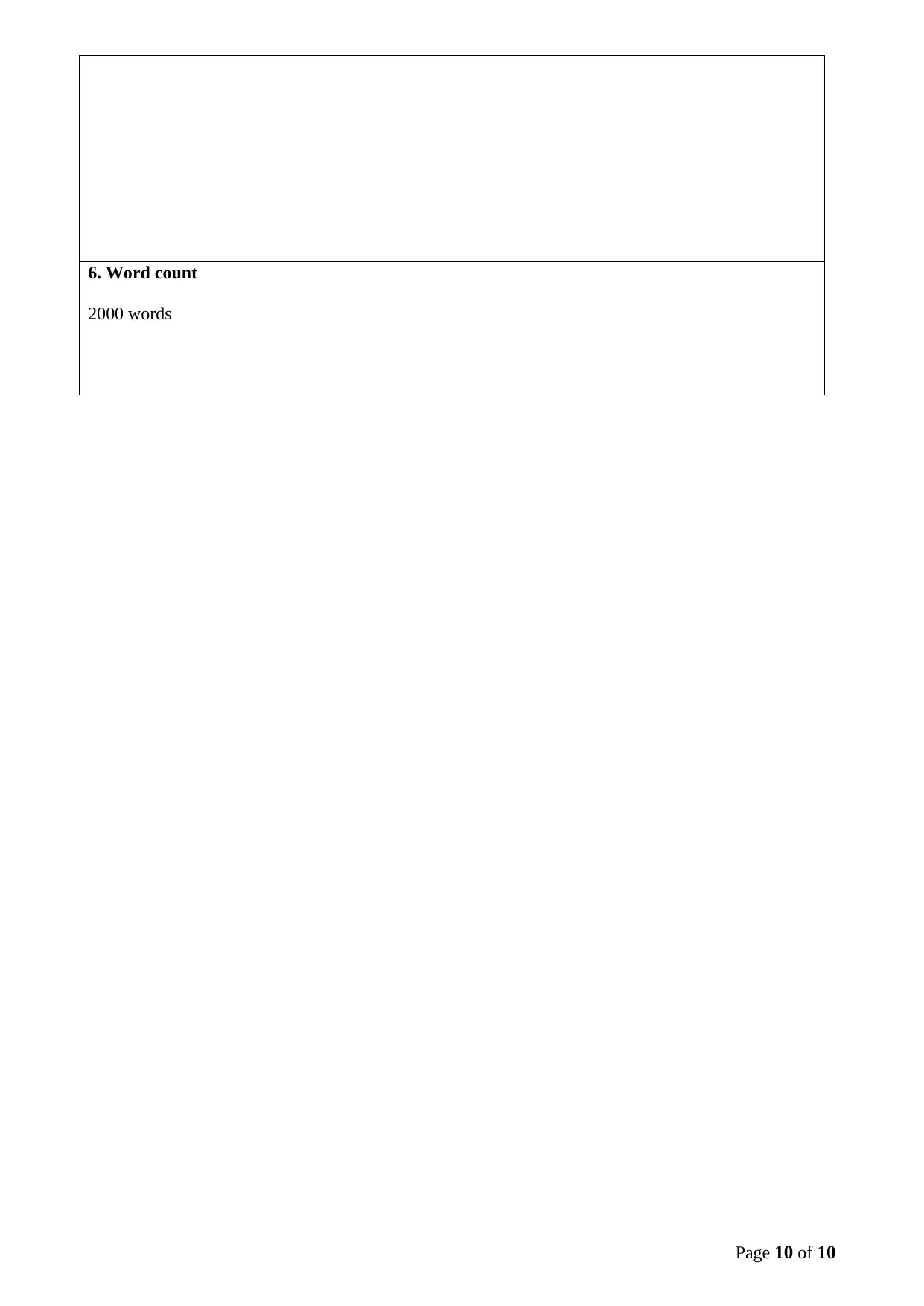
6. Word count
2000 words
Page 10 of 10
2000 words
Page 10 of 10
1 out of 10
Related Documents
Your All-in-One AI-Powered Toolkit for Academic Success.
+13062052269
info@desklib.com
Available 24*7 on WhatsApp / Email
![[object Object]](/_next/static/media/star-bottom.7253800d.svg)
Unlock your academic potential
Copyright © 2020–2025 A2Z Services. All Rights Reserved. Developed and managed by ZUCOL.



